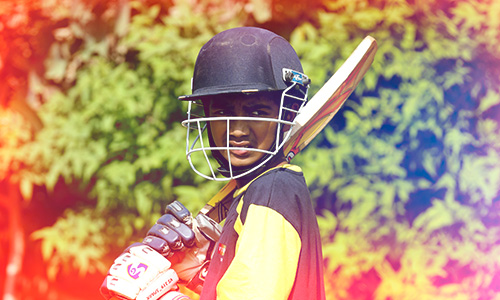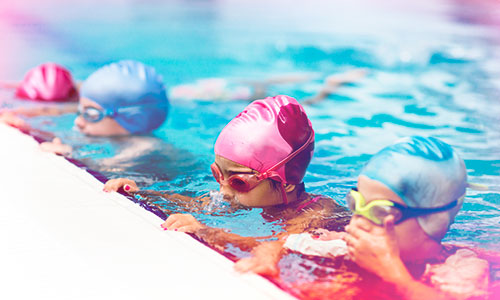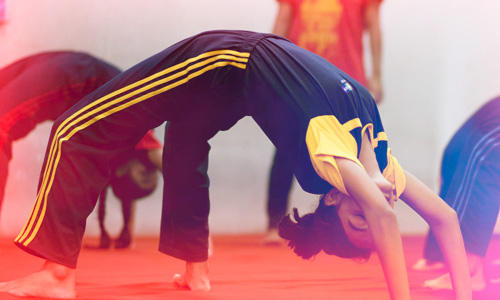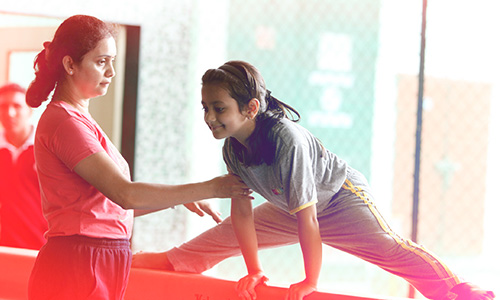
Swimming
Swimming is an individual & team racing sport that requires the use of one’s entire body to move through water. The sport takes place in pools & open water [e.g. in a sea or lake]. Competitive swimming is one of the most popular Olympic sports, with varied distance events in Butterfly, Backstroke, Breaststroke and Freestyle & Individual Medley. In addition to these Individual events, four swimmers can take part in either a Freestyle or Medley relay. A medley relay consists of four swimmers who will each swim a different stroke, ordered as Backstroke, breaststroke, butterfly & Freestyle. Swimming each stroke requires a set of specific techniques; in competition, there are divergent regulations relating to the acceptable form for each individual stroke.
Swimming
Swimming is an individual & team racing sport that requires the use of one’s entire body to move through water. The sport takes place in pools & open water [e.g. in a sea or lake]. Competitive swimming is one of the most popular Olympic sports, with varied distance events in Butterfly, Backstroke, Breaststroke and Freestyle & Individual Medley. In addition to these Individual events, four swimmers can take part in either a Freestyle or Medley relay. A medley relay consists of four swimmers who will each swim a different stroke, ordered as Backstroke, breaststroke, butterfly & Freestyle. Swimming each stroke requires a set of specific techniques; in competition, there are divergent regulations relating to the acceptable form for each individual stroke.
Swimming at VIBGYOR Group
- Introduction to Basic swimming movements.
- To make students friendly with water.
- To develop co-ordination ability.
- To develop overall flexibility through different skills of Swimming.
- To evaluate the students with the different strokes.
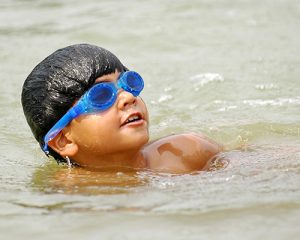
Fun in the water spending time in the water can also be positive for children’s mental health, the Centres for Disease Control and Prevention reports. Swimming may improve mood and decrease anxiety. Families that spend time swimming together could experience enhanced family bonding. Kids could enjoy swimming more than other types of exercise, so, if you provide your children with opportunities to swim, they may be more likely to exercise.
- Full body workout: Swimming uses all the muscles in the body so whether you swim a gentle breaststroke or hammer butterfly, you will get a full body workout. Plus, exercising in water makes your body work harder so 30 minutes in a pool is worth 45 minutes of the same activity on land.
- Great for general wellbeing: Just 30 minutes of swimming three times a week alongside a balanced, healthy diet and lifestyle is one of the best ways to stay fit and healthy and maintain a positive mental outlook. Do it with friends, and it’s even more fun!
- De-stresses and relaxes: Whether its work stressing you out, the kids being a nightmare, or just life in general, we all get times we just want to SCREAM. Well, help is at hand. Swimming regularly can lower stress levels, reduce anxiety and depression, and improve your sleep patterns. Feeling the mental benefits of swimming takes just a light swim.
- Lowers the risk of diseases: As well as being a great form of cardiovascular exercise, swimming just 30 minutes a week can help to guard against heart disease, stroke and type 2 diabetes.
- Supports the body: Water supports up to 90 per cent of the body’s weight. So if you sprained an ankle at Monday night football or have a long term injury or illness, swimming is a brilliant way to stay active.
- Increases your energy levels: Inactivity and not ageing is often responsible for people’s lack of energy. Just 30 minutes of swimming three times per week can boost your energy levels through increased metabolic rate.
- Exercising without the sweat: If sweating puts you off other forms of exercise, fear not! As a swimmer, you’ll never feel sweaty no matter how hard you work because the water around you is constantly cooling you down.
Splashing around in the pool appeals to many youngsters. While spending time in the water is often enjoyable, it has other benefits, too. Explore the positives of swimming to learn how your children will profit in the short and long term from learning water safety and swim strokes.
You may have heard that experts recommend adults & kids get 150/60 minutes of moderate activity or 45 minutes of vigorous activity every day. Swimming is an excellent way to work your entire body & cardiovascular system. An hour of swimming burns almost as many calories as running, without all the impact on our bones and joints.




